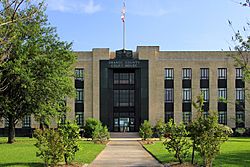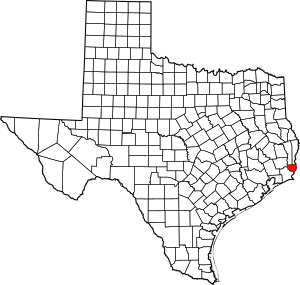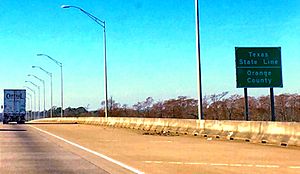Orange County, Texas facts for kids
Quick facts for kids
Orange County
|
|||
|---|---|---|---|

The Orange County Courthouse in Orange
|
|||
|
|||

Location within the U.S. state of Texas
|
|||
 Texas's location within the U.S. |
|||
| Country | |||
| State | |||
| Founded | January 5, 1852 | ||
| Named for | Orange fruit | ||
| Seat | Orange | ||
| Largest city | Orange | ||
| Area | |||
| • Total | 380 sq mi (1,000 km2) | ||
| • Land | 334 sq mi (870 km2) | ||
| • Water | 46 sq mi (120 km2) 12% | ||
| Population
(2020)
|
|||
| • Total | 84,808 |
||
| • Density | 220/sq mi (80/km2) | ||
| Time zone | UTC−6 (Central) | ||
| • Summer (DST) | UTC−5 (CDT) | ||
| Congressional district | 14th | ||
Orange County is a county located in the very southeastern part of Texas. It shares a border with Louisiana. This area is part of what is known as the Golden Triangle of Texas.
In 2020, about 84,808 people lived here. The main city and county seat is Orange. The county is also part of the larger Beaumont–Port Arthur metropolitan area.
Contents
History of Orange County
Orange County was created in 1852. It was formed from parts of Jefferson County. The county got its name from the orange fruit. Early settlers grew these citrus fruits near the mouth of the Sabine River.
However, orange trees and citrus farms are no longer found in Orange County. This is because of cold winter weather, which can bring frosts. Citrus fruits grow in winter, making them easily damaged by cold. Because of this, citrus farming in Texas moved to the warmer Rio Grande Valley.
Something similar happened in Florida. Citrus farms moved south from places like Citrus County and Orange County. This was also due to cold winter freezes. Farmers moved their crops to areas with milder winters.
During World War II, Orange County became a major center for shipbuilding. Many ships were built here for the United States Navy and its allies. A big company called Consolidated Steel Corporation was in the town of Orange. They built many warships.
The first warship built there was the USS Aulick (DD-569) in 1942. The last one was the USS Carpenter (DD-825) in 1945–46. During the war, this shipyard employed as many as 20,000 people.
Geography of Orange County
Orange County covers a total area of about 380 square miles. About 334 square miles of this is land. The remaining 46 square miles, or 12%, is covered by water.
The Sabine River forms the eastern border of Orange County. Sabine Lake is to its southeast. The Neches River is on its northwest side.
The land in Orange County is very flat. Most of the county is only a few feet above sea level. The soil is quite sandy, which is common for areas near the Gulf of Mexico. You can find saltwater marshes in the southeastern part of the county. The Piney Woods forest area is in the northern part.
Neighboring Areas
Orange County shares borders with these counties and parishes:
- Jasper County (north)
- Newton County (north)
- Hardin County (northwest)
- Jefferson County (west)
- Calcasieu Parish, Louisiana (east)
- Cameron Parish, Louisiana (southeast)
Protected Natural Areas
A part of the Big Thicket National Preserve is located in Orange County. This preserve helps protect unique plants and animals.
Communities in Orange County
Orange County has several cities and towns:
Cities
- Bridge City
- Orange (This is the county seat)
- Pine Forest
- Pinehurst
- Port Arthur (Most of this city is in Jefferson County)
- Rose City
- Vidor
- West Orange
Census-Designated Places
These are areas that are like towns but are not officially incorporated as cities:
Unincorporated Communities
Ghost Towns
These are places where people used to live but are now abandoned:
Population and People
In 2020, Orange County had a population of 84,808 people. The population has changed over the years. For example, in 1860, there were only 1,916 people. By 1950, the population had grown to 40,567.
In 2000, there were 84,966 people living in the county. About 88% of the people were White, and about 8% were African American. About 3.6% of the population was Hispanic or Latino.
The average age in the county in 2000 was 36 years old. About 27% of the population was under 18 years old. About 13% were 65 years or older.
Government of Orange County
The Orange County Courthouse is where the county's legal matters are handled. The county is led by a five-member Commissioners' Court. The Republican County Judge John Gothia is in charge of this court.
Orange County is part of Texas House District 21. This district is represented by Republican Dade Phelan from Beaumont.
United States Congress Representation
Orange County is represented in the U.S. Congress by two Senators and one Representative.
- The Senior Senator for Texas is John Cornyn, a Republican, first elected in 2002.
- The Junior Senator for Texas is Ted Cruz, a Republican, first elected in 2012.
- The county is in District 14 for the House of Representatives. This district is represented by Randy Weber, a Republican. He was first elected in 2012.
Economy of Orange County
The main economic activities in Orange County include refining petroleum (oil), making paper, rice farming, and shrimping.
In the past, Orange County was famous for building warships. Today, some old warships are being taken apart for their metal in nearby Jefferson County. This process, called shipbreaking, provides jobs for people in Orange County.
Local newspapers in the county include the Orange Leader. There are also weekly papers like the Penny Record and County Record from Bridge City, and the Vidor Vidorian from Vidor.
Transportation in Orange County

Airports
The Orange County Airport handles flights for private planes. For commercial flights, people use the Southeast Texas Regional Airport in Port Arthur.
Major Highways
Several important highways pass through Orange County:
 Interstate 10
Interstate 10 U.S. Highway 90
U.S. Highway 90 State Highway 12
State Highway 12 State Highway 62
State Highway 62 State Highway 73
State Highway 73 State Highway 87
State Highway 87
Education in Orange County
Five different school districts serve the students in Orange County:
- Bridge City ISD
- Little Cypress-Mauriceville Consolidated ISD
- Orangefield ISD
- Vidor ISD
- West Orange-Cove Consolidated ISD
See also
 In Spanish: Condado de Orange (Texas) para niños
In Spanish: Condado de Orange (Texas) para niños



